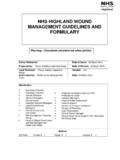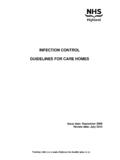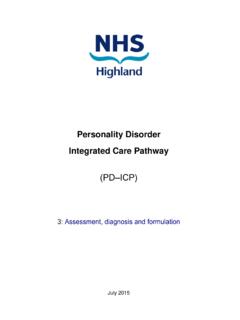Transcription of id1312 - NHS Highland
1 Policy for the Safe Handling of Sharps Health & Safety Infection Prevention & Control Occupational Health Warning Document uncontrolled when printed Policy Reference: id1312 Date of Issue: September 2011. Prepared by: Bob Summers, Date of Review September 2013. Health & Safety Linda Rawlinson, Occupational Health, Liz McClurg, Infection Prevention & Control Lead Reviewer: Liz McClurg Version: Two Infection Control Manager Authorised by: NHS Highland Date September 2011. Control of Infection Committee Distribution General Managers All Wards Clinical Directors All departments, clinical and non clinical Lead Nurses Lead Midwives Lead AHPs Domestic, Portering ,Catering Managers Estates Managers Admin and clerical teams Method CD Rom E-mail Paper Intranet Warning Document uncontrolled when printed Policy Reference: Date of Issue: September 2011.
2 Prepared by: Bob Summers, Health & Safety Date of Review: September 2013. Linda Rawlinson, Occupational Health, Liz McClurg, Infection Prevention & Control Lead Reviewer: Liz McClurg Infection Control Manager Version: one Authorised by: NHS Highland Control of Infection Committee Page 1 of 12. INDEX. Page No. Contents 3. Driver diagram 4. Introduction Terms & Definitions 5. Roles and Responsibilities 6/7. Procedures required for the safer handling of sharps - Stage 1: Preparing to use a sharp 8. - Stage 2: Using a sharp 9. - Stage 3: Awaiting Disposal of a sharp - Stage 4: Disposal of sharps 10.
3 - Stage 5: Storage & Transportation 11. Training Legislation & Guidance Warning Document uncontrolled when printed Policy Reference: Date of Issue: September 2011. Prepared by: Bob Summers, Health & Safety Date of Review: September 2013. Linda Rawlinson, Occupational Health, Liz McClurg, Infection Prevention & Control Lead Reviewer: Liz McClurg Infection Control Manager Version: one Authorised by: NHS Highland Control of Infection Committee Page 2 of 12. Staff competency Is a sharp necessary for the procedure? Preparing to use a sharp Safer needle devices Assess the environment Assess the patient Equipment AIM Team work Using a sharp Neutral zone To reduce the Procedures in open wounds or body cavities number of Re-sheathing of needles and separating sharps from their holder Sharps injuries by adhering to the Safe Handling of Sharps Policy Awaiting disposal of a The sharp must not be bent.
4 Broken or re-sheathed prior to disposal sharp Disposal of Responsibility sharps Sharps container Patients and members of the public Storage and transportation of Storage used sharps Transportation Warning Document uncontrolled when printed Policy Reference: Date of Issue: September 2011. Prepared by: Bob Summers, Health & Safety Date of Review: September 2013. Linda Rawlinson, Occupational Health, Liz McClurg, Infection Prevention & Control Lead Reviewer: Liz McClurg Infection Control Manager Version: one Authorised by: NHS Highland Control, Of Infection Committee Page 3 of 12.
5 1. INTRODUCTION. The purpose of this policy is to inform all staff and managers of the key issues to consider when developing safer working practices for the prevention of occupational exposures to blood-borne pathogens, blood and body fluids associated with the use of sharps in line with general employers' requirements set within the Health and Social care Act 2008, the Management of Health & Safety at Work Regulations 1999 and in the more specific requirements under the Control of Substances Hazardous to Health 2002 (COSHH). The following NHS Highland policies are also relevant and should be read in conjunction with this policy: Health & Safety Policy Control of Substances Hazardous to Health Policy (COSHH).
6 Waste Management Policy Infection Control Policies (Needlestick Injury and Similar Accidents involving Blood and Body Fluids Policy). The COSHH Regulations 2002 cover hazardous substances including biological agents (pathogenic micro-organisms) and contain a schedule of special provisions relating to biological agents. The regulations, together with the associated Approved Codes of Practice, require NHS Highland to assess the risks of exposure to biological agents (micro-organisms) and either prevent exposure (where reasonably practicable) or control it adequately.
7 The Health and Social Care Act 2008 - Code of Practice for Health and Adult Social care on the prevention and control of infections and related guidance requires NHS Highland to have a policy in place for the safe handling and disposal of sharps. Systems must be in place to ensure staff are aware of this policy and that it is implemented. 2. TERMS AND DEFINITIONS. What is a sharp? For the purpose of this policy, a sharp is defined as anything that can puncture the skin. Examples include needles, razors, blades, scissors, ampoules, glass shards, broken crockery, syringes attached to needles, intravenous administration set spikes, sharp bones and teeth.
8 A used or contaminated sharp is any sharp that may be contaminated with blood or other body substances. Sharps can also be contaminated with medicines, chemicals and other substances What are the risks? A penetrating injury with a used sharp can transmit a wide range of infections Blood-borne viruses can also be transmitted via this route, the most significant being Warning Document uncontrolled when printed Policy Reference: Date of Issue: September 2011. Prepared by: Bob Summers, Health & Safety Date of Review: September 2013. Linda Rawlinson, Occupational Health, Liz McClurg, Infection Prevention & Control Lead Reviewer: Liz McClurg Infection Control Manager Version: one Authorised by: NHS Highland Control, Of Infection Committee Page 4 of 12.
9 Human Immuno Deficiency Virus, hepatitis B and hepatitis C. Micro-organism may be present in any body substances staff must exercise extreme caution at all times when handling used sharps. 3. ROLES AND RESPONSIBILITIES. Under The Health and Social Care Act 2008 Health Act (2006), NHS Highland must ensure that this policy is up-to-date and implemented. This policy applies to all staff groups, including agency, locum, visitors and others. Executive/Senior Management The Chief Executive is responsible for ensuring that there is an effective system for the implementation of this policy.
10 Other Executives and Senior Managers are required to be familiar with the contents of this policy and support its implementation throughout NHS Highland and includes agency and contracted personnel. Executives and Senior Managers are responsible for ensuring that there is adequate resource (time, finance, and training) to support the implementation of this policy and ensure that mechanisms exist to audit its effectiveness. Infection Prevention & Control Team The Infection Control Manager together with Health & Safety Manager is responsible for over seeing the implementation of the policy.







